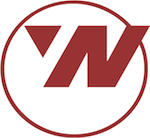This is part 3 in a series on the redesign of fetchsoftworks.com; the series starts at Part 1: My Original Sin.
In Need of a Logo

Just as we were finally ready to dive into the website redesign, all progress had come to a halt. The site was to represent our company, and for that it needed a company logo. Since 2001 our logo had been a 3D rendering of the Fetch dog. It was, and is, a great logo — cute, colorful, easily identified. The problem was that it wasn’t just a company logo, it was also the icon and logo for the Fetch product.
Our identity as a company and Fetch’s identity were tied together like conjoined twins, and separating them without losing the brand recognition we had built up promised to be a tricky operation. But, unless we wanted to forever remain a single-product company, it was an operation we had to attempt. And, since our new company website needed a company logo, the new logo had to come first. We set out in search of a logo designer.
Finding a Logo Designer
Just as we had been keeping our eyes open for web designs we liked, my colleagues and I started to stare at magazine ads and delivery trucks, trying to figure out what we liked in a logo. Naturally we liked the iconic simplicity of a number of classic graphic logos, such as the Target bullseye ![]() , the Nike Swoosh
, the Nike Swoosh  and the Apple, um, apple
and the Apple, um, apple  . I was also struck by less famous examples, such as the clicked cloud
. I was also struck by less famous examples, such as the clicked cloud  of fellow Mac indie developer Clickable Bliss. I also admired the typographical cleverness of the
of fellow Mac indie developer Clickable Bliss. I also admired the typographical cleverness of the  logo, with its secret symbol.
logo, with its secret symbol.
I started reading the Brand New blog, which compares brand logos with their new (and sometimes not at all improved) replacements. Our break came when my Googling turned up a blog post titled “The world’s best logo designers?” Most of the designers listed — geniuses like Paul Rand (IBM  ) and Saul Bass (AT&T
) and Saul Bass (AT&T  ) — were, sadly, no longer with us. But the post also mentioned Joe Finocharrio, who is alive and well in New York City.
) — were, sadly, no longer with us. But the post also mentioned Joe Finocharrio, who is alive and well in New York City.
Joe Finocchario
Paging through his online portfolio, I was immediately attracted to the simplicity and strength of Joe’s logos. I especially liked the ones that included some sort of typographical trickery, like his classic mark for Northwest Airlines, with its implied “W” (which literally points northwest) and the missing stroke of his  logo. He has a knack for saying a lot with very little.
logo. He has a knack for saying a lot with very little.
But would he want to work for us? After all, one of his recent projects had been the redesign of the  logo. Cisco has 67,000 employees and $40 billion in annual revenue. Fetch Softworks had 3 full time employees, and, well, somewhat less than $40 billion in annual revenue. I called him, again feeling a bit presumptuous in even asking, and again found myself talking with a Fetch user who was interested in working with us.
logo. Cisco has 67,000 employees and $40 billion in annual revenue. Fetch Softworks had 3 full time employees, and, well, somewhat less than $40 billion in annual revenue. I called him, again feeling a bit presumptuous in even asking, and again found myself talking with a Fetch user who was interested in working with us.

